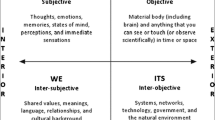Abstract
Mindfulness is the process of actively drawing novel distinctions. It results in context-sensitivity and a heightened awareness of alternative perspectives (Langer in Higher stages of human development: Perspectives on adult growth. Oxford University Press, New York, pp. 114–136, 1989). By being “mindful”, one continually draws from the present experiences and creates expanded possibilities (Alexander et al. in Higher stages of human development: Perspectives on adult growth. Oxford University Press, New York, pp. 114–136, 1990). Mindfulness is multifaceted and needs to be examined from multiple perspectives. In order to understand the concept of mindfulness and its application in daily life, it is very important to come to a standard consensus on mindfulness and study it empirically. In the chapter, series of definition is given to put mindfulness into a scientific context. The five behavioral components based on or related to behavioral training procedures are identified to understand critical mindfulness. The benefits of cultivating mindfulness in the well-being are discussed.
Access this chapter
Tax calculation will be finalised at checkout
Purchases are for personal use only
Similar content being viewed by others
References
Alexander, C. N., Druker, S. M., & Langer, E. (1990). Introduction: Major issues in the exploration of adult growth. In C. N. Alexanader & E. Langer (Eds.), Higher stages of human development: Perspectives on adult growth (pp. 114–136). New York, NY: Oxford University Press.
Baer, R. A., Smith, G. T., Hopkins, J., Krietemeyer, J., & Toney, L. (2006). Using self-report assessment methods to explore facets of mindfulness. Assessment, 13(1), 27–45.
Bauer, D. J., & Curran, P. J. (2005). Probing interactions in fixed and multilevel regression: Inferential and graphical techniques. Multivariate Behavioral Research, 40(3), 373–400.
Brewer, J. (2014, August). Mindfulness in the military. American Journal of Psychiatry, 803–806. doi:10.1176/appi.ajp.2014.14040501.
Carmody, J., & Baer, R. A. (2008). Relationships between mindfulness practice and levels of mindfulness, medical and psychological symptoms and well-being in a mindfulness-based stress reduction program. Journal of Behavioral Medicine, 31, 23–33.
Chiesa, A. (2013). The difficulty of defining mindfulness: Current thought and critical issues. Mindfulness, 4, 255–268.
Commons, M. L & Adhikari, D. (2015, June). Components of Mindfulness. Presented at the 30th Annual Symposium for the Society for Research in Adult Development, Salem, Massachusetts.
Commons, M. L., Goodheart, E. A., Pekker, A., Dawson, T. L., Draney, K., & Adams, K. M. (2007). Using Rasch scaled stage scores to validate orders of hierarchical complexity of balance beam task sequences. In E. V. Smith, Jr. & R. M. Smith (Eds.), Rasch Measurement: Advanced and Specialized Applications (pp. 121–147). Maple Grove, MN: JAM Press.
Commons, M. L. (2001). The notion of events and three ways of knowing: Problems with mentalistic explanations, freewill, self, soul, and intrinsic motivation. Retrieved from http://www.dareassociation.org/Papers/Commons2001new.pdf.
Creswell, J. D., & Lindsay, E. K. (2014). How does mindfulness training affect health? A mindfulness stress buffering account. Current Directions in Psychological Science, 23(6), 401–407. doi:10.1177/0963721414547415.
Creswell, J. D., Irwin, M. R., Burklund, L. J., Lieberman, M. D., Arevalo, J. M., Ma, J., et al. (2012). Mindfulness-based stress reduction training reduces loneliness and pro-inflammatory gene expression in older adults: A small randomized controlled trial. Brain, Behavior, and Immunity, 6(7), 1095–1101. doi:10.1016/j.bbi.2012.07.006.
Davidson, R. J., & Kaszniak, A. W. (2015). Conceptual and methodological issues in research on mindfulness and meditation. American Psychologist, 70(7), 581–592.
Davidson, R. J., Kabat-Zinn, J., Schumacher, J., Rosenkranz, M., Muller, D., Santorelli, S., & Sheridan, J. (2003). Alterations in brain and immune function produced by mindfulness meditation. Psychosomatic Medicine, 65(4), 564–570.
Fiocco, A. J., & Mallya, S. (2015). The importance of cultivating mindfulness for cognitive and emotional well-being in late Life. Journal of Evidence-Based Complementary and Alternative Medicine, 20(1), 35–40. doi:10.1177/2156587214553940.
Hölzel, B. K., Lazar, S. W., Gard, T., Schuman-Olivier, Z., Vago, D. R., & Ott, U. (2011). How does mindfulness meditation work? Proposing mechanisms of action from a conceptual and neural perspective. Perspectives on Psychological Science, 6(6), 537–559. doi:10.1177/1745691611419671.
Kahneman, D., & Deaton, A. (2010). High income improves evaluation of life but not emotional well-being. Proceedings of the National Academy of Sciences of the United States of America, 107(38), 16489–16493. doi:10.1073/pnas.1011492107.
Kennard, B. D., Emslie, G. J., Mayes, T. L., Nightingale-Teresi, J., Nakonezny, P. A., Hughes, J. L. et al. (2008). Cognitive-Behavioral therapy to prevent relapse in pediatric responders to pharmacotherapy for major depressive disorder. Journal of the American Academy of Child and Adolescent Psychiatry, 47(12), 1395–1404. http://doi.org/10.1097/CHI.0b013e31818914a1.
Killingsworth, M. A., & Gilbert, D. T. (2010). A wandering mind is an unhappy mind. Science, 330(6006), 932. doi:10.1126/science.1192439.
Koopmann-Holm, B., Sze, J., Ochs, C., & Tsai, J. L. (2013). Buddhist-inspired meditation increases the value of calm. Emotion, 13(3), 497–505. doi:10.1037/a0031070.
Langer, E., Chanowitz, B., Palmerino, M., Jacobs, S., Rhodes, M., & Thayer, P. (1990). Nonsequential development and aging. In C. N. Alexanader & E. Langer (Eds.), Higher stages of human development: Perspectives on adult growth (pp. 114–136). New York, NY: Oxford University Press.
Langer, E. J. (1989). Mindfulness. Reading, MA: Addison-Wesley.
Leary, M. R., & Tate, E. B. (2007). Commentaries: The multi-faceted nature of mindfulness. Psychological Inquiry, 18(4), 251–255. doi:10.1080/10478400701598355.
Piaget, J., & Cook, M. T. (1952). The origins of intelligence in children. New York, NY: International University Press.
Shapiro, S., Oman, D., Thoresen, C., Plante, T., & Flinders, T. (2008). Cultivating mindfulness: Effects on well-Being (English). Journal of Clinical Psychology, 64(7), 840–862.
Young, S. (2006). What is mindfulness? Retrieved from http://www.shinzen.org/Retreat%20Reading/What%20is%20Mindfulness.pdf.
Whitfield, H. J. (2006). Towards case-specific applications of mindfulness-based cognitive-behavioral therapies: A mindfulness-based rational emotive behavior therapy (English). Counselling Psychology Quarterly, 19(2), 205–217.
Author information
Authors and Affiliations
Corresponding author
Editor information
Editors and Affiliations
Appendix 1
Appendix 1
See Fig. 1.
Equation 1
Equation 2
Rights and permissions
Copyright information
© 2016 Springer International Publishing Switzerland
About this chapter
Cite this chapter
Commons, M.L., Adhikari, D. (2016). Possible Components of Mindfulness. In: Fatemi, S. (eds) Critical Mindfulness. Springer, Cham. https://doi.org/10.1007/978-3-319-30782-4_13
Download citation
DOI: https://doi.org/10.1007/978-3-319-30782-4_13
Published:
Publisher Name: Springer, Cham
Print ISBN: 978-3-319-30781-7
Online ISBN: 978-3-319-30782-4
eBook Packages: Behavioral Science and PsychologyBehavioral Science and Psychology (R0)





